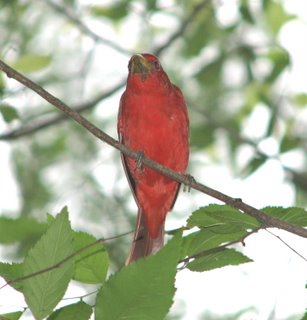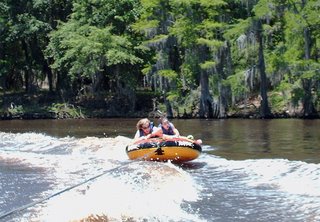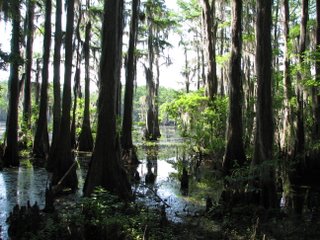Gulf Coast Bird Observatory has received a grant to do a comprehensive search for the Ivory-billed Woodpecker in Texas. On Saturday I attended an orientation meeting for volunteers at the Big Thicket Field Research Station in Saratoga. John Arvin led the meeting, which was very informative. One of the attendees was John Dennis, son of ornithologist John V. Dennis, who had searched for Ivory-bills back in the 1960s, and had reported sightings in the Big Thicket.
A substantial part of the discussion focused on what we know and don't know about Ivory-bills. there is considerable uncertainty about the bird's habits. What we do know is mostly derived from the journals of 19th century naturalists, such as Audubon, and the work done by James Tanner, who studied the tiny population of birds in the Singer Tract. It is unknown whether Tanner's findings hold true for the Ivory-bill in other parts of its range, and there is the danger of extrapolating too much from limited information.
Some of the historic literature appears to contradict the recent experience in Arkansas. Ornithologists of the 19th and early 20th centuries seemed to have little trouble finding Ivory-bills where they were present. They described the birds as sociable and loudly vocal, traits which made them relatively easy to locate (and shoot). Contrast this with the almost impossibly wary and quiet bird(s) in Arkansas.
The continuing search in Arkansas was a hot topic. We endured an extended pixel-by-pixel analysis of the Luneau video, which has become the Zapruder film of Ivory-bill searchers. I'm still unconvinced that the bird in the video - one of the worst videos ever made - is anything more than a blurry Pileated Woodpecker. And we learned that results of this past field season in Arkansas are unlikely to end the controversy. Word is out that no conclusive evidence was found, despite a massive effort.
Different people at the meeting had differing ideas of what constitutes solid evidence. Some put their faith in recordings of "kent" calls and double-raps. Others see a smoking gun in physical evidence such as bark scaling and large cavity excavation. Personally I don't find any of the auditory and physical evidence compelling by itself, because in every instance there are other possible explanations for the phenomena. I've heard Blue Jays that sound like Ivory-bills, and there are other woodpecker and mammal species that engage in bark stripping. I'm a skeptic and I want definitive proof. Give me one good photograph, or a documented sighting (with full details) by multiple qualified observers.
On Sunday morning I walked Timber Slough Road in the Jack Gore Baygall Unit of the Big Thicket Preserve with John Arvin and some of the other volunteers. The road had been cleared since the hurricane, and was in good condition - we went almost as far as the river before turning back. It was an opportunity to see some of the best accessible habitat and how it had been been effected by the hurricane. We didn't expect to find any Ivory-bills, but who knows?
Hurricane Rita had damaged and knocked down many large trees, opening up the forest. Woodpecker workings were hard to identify amid the wreckage - we saw many trunks that had been stripped of bark where falling trees had struck them. Many of the trees still standing were dead, and for the next few years the abundance of snags and rotting timber should produce a feeding bonanza for woodpeckers. During my walk I counted about 15 Pileated Woodpeckers, also lesser numbers of Red-bellied and Downy Woodpeckers. No Ivory-billed Woodpecker (sigh).
Birding was good along Timber Slough Road, with relatively few bothersome insects. Highlights included a Swallow-tailed Kite and the first White-breasted Nuthatch I've ever seen in Southeast Texas (also the first one I've ever seen in a bald cypress). Birds were singing everywhere, with 3 species of vireos and at least 7 species of warblers. In areas of pine and cypress we had several Yellow-throated Warblers on territory. Two Magnolia Warblers and a Yellow Warbler were migrants south of their breeding ranges. Here's a photo of a Summer Tanager taken in a baygall beside the road.







